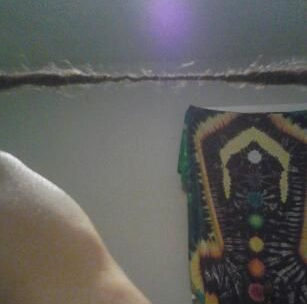I have a thin area in one of my dreads with very little hair. Help! - Dreadlocks FAQ's

This is a "thin spot". It's due to having less hair in an area of the dread. This can be due to damage like cutting or ripping or even pulling on the dread hard enough to cause hair to break. When it appears on many dreads It's often a sign of dry, brittle hair, since dry hair is weaker and more prone to breakage.
Each hair has a lifespan. A period of time that it does what it's designed to do and after it's useful life is complete it's shed and new hair is grown to replace it. Since hair in a dread remains in the dreads after it has been shed it has a chance to stick around much longer. If you keep the hair moisturized you can maintain it's strength longer and extend it's life for many years. Most of the time there are hundreds of hairs in each dread, all backing each other up, so breakage goes un-noticed and the dread maintains it's integrity.
On a long enough timeline (unless you keep your dreads in a box on the shelf) every hair will reach a point where it no longer has the strength to resist day to day forces, like gravity and little nephews. At this point it breaks. When a high enough percentage of the hair has broken the dread will pull apart completely, or partially, hanging by very few hairs. Usually breakage occurs at or near the tips where the hair is the oldest.
Of course thinner dreads have less hair and therefore less strength to begin with. Thick dreads also tend to have a well protected core that never sees sunlight and never comes in contact with anything. It's not surprising then that breakage is much more common in small dreads. Other factors play a big part in hair strength. Dying and Bleaching, extreme heat, Sun/UV Exposure, mechanical forces, moisturization, and nutrition (eating veggies and getting all your vitamins really makes a difference in your hair strength and the speed at which your hair grows).
Does this mean you should only grow huge dreads, that you never touch and moisturize obsessively while you stay indoors with the curtains drawn eating only vegetables? Probably not. Maybe if you're going for a world record - longest dreads ever or something...
What it does mean is that you should avoid things that can be extremely damaging, like over bleaching and trimming loose hair at the roots. Getting sand stuck in your locks can cause damage as well. If you know you're going to grow them long try to help them out by eating well, maybe even taking a supplement, and by keeping them moisturized, which keeps the hair strong and protects it. You can also minimize mechanical stresses by avoiding harmful maintenance practices. For example, many times maintenance is done with a common crafting crochet hook and care is not taken to prevent stretching and breaking hair. Over time this will weaken and break hair which will ultimately weaken the dreads. Cutting and ripping cause obvious damage that you can see right when it happens. Most damage occurs over time, little by little. Obsessive habbits, like twisting a particular dread at the roots while you read will take it's tole over time, making it a lot harder to pinpoint the cause of the damage. Using the same two dreads to tie back the rest is another common source of damage. It's better to change it up and use different dreads each time to tie them up.
You may wonder what effect clockwise rubbing has on hair strength. After all it is a rubbing motion which is a source of mechanical stress. Healthy hair can be clockwise rubbed to assist knotting without any negative consequences as long as it's done properly. Pressing extra hard, continuing to rub long after it's needed, or doing it repeatedly to the same spot on the same dread can cause extra stress. When the instructions are followed even the thinnest dreads can be clockwise rubbed with no adverse effects. This is because each section of each dread is only rubbed for less than a minute, once or twice, before it has enough knots to lock. After that there is no need to continue to rub that area. It's also done at the roots where hair is strongest and healthiest and most resistant to stress. Even so, if you clockwise rubbed one dread, hour after hour, day after day, non-stop in the same place, it would only be a matter of time before you'd stress out the hair and cause damage.
Repairing Damage
Repairing damage in thin, weak areas is tough, especially when the surrounding areas are weak as well due to the hair being dry and brittle. See this FAQ for some options: How can I repair a thin/weak spot in the body of a dread?
